Fax Emulation and Analysis over T1 E1, & Analog
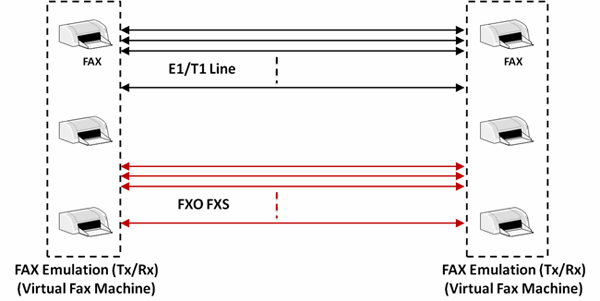
Overview
A fax (short for facsimile), is the transmission of scanned printed material (text or images) via voice grade telephone lines. High speed rates as high as 33.4 kbps (V.34 or Super Group 3) can be achieved over conventional telephone lines. When combined with compression schemes, many pages of print can be transmitted in minutes. When transmitted over regular telephone lines, a simple protocol called T.30 is used by both fax machines to negotiate transmission parameters and provide reliable transfer of scanned documents. Recently fax transmission is also possible over voice circuits that are packet based. This form of transmission usually demodulates the modulated signal back to the original scanned bits and then transmits them via packets to the distant end where they are remodulated to be sent to the destination fax machine.
GL has recently introduced single and bulk (120's) call Fax Emulator. This software is capable of transmitting and receiving over many T1 E1 timeslots or through two-wire FXO and FXS lines. The software can emulate many "virtual fax machines" – both transmitter as well as receiver.
The application supports fax over v27, v29, v17 and v34 ITU-T modems. The emulator can transmit multiple pages of fax image, as of now up to 1300 pages can be sent per fax call. Detailed information of the fax call can be obtained during the call. Upon call termination, a summary of the call is provided which contains details about the call status.
Fax Emulator can be used with any GL Protocol Emulation tools such as MAPS™ CAS emulator, MAPS™ APS, MAPS™ ISDN emulator, and MAPS™ SS7 emulator to emulate complete real time Fax calls.
GL also supports FaxScan™ (fax decoder/demodulator) software that processes 2-Wire or 4-Wire captures and analyzes voiceband traffic files for fax traffic. The application operates either stand-alone from a batch file or as part of the GL's VoiceBand Analysis application to produce decoded fax image TIFF files and other transmission information.
Fax Emulation Applications
Typical applications of our Fax Emulation software are load testing of fax servers, qualification testing of T.38 Gateways, testing of ATAs (Analog Terminal Adapters), testing of fax machines, and many more.
Features and applications are:
- Load Testing - sending or receiving up to 120 fax calls simultaneously; one end can send and receive simultaneously on different timeslots; over many T1 E1 lines; over many FXO or FXS lines; any signaling protocol can be used such as PRI ISDN, SS7, or CAS
- V.34 Testing - there are many fax modulations and V.34 is the fastest, permitting many pages to be transmitted quickly
- High Speed / Low Speed - fax protocol consists of low speed handshaking and high speed image transmission
- Multiple Pages - single or multiple page fax transmission is supported
- With or without ECM - Error Correction Mode permits the retransmission of erred pages
- Alaw and µlaw - In TDM networks, USA uses µlaw and the rest of the world use Alaw – both coding standards are supported
- Over T1 E1, PSTN, IP - Fax transmission may be over T1 E1 digital lines, over PSTN FXO / FXS lines, or over VoIP (packet) networks
- Output Tiff Image
Supported Platforms
- Octal/QuadXpress T1E1 Boards
- Dual Express T1 E1 (PCIe) Boards
- tProbe™ T1 E1/VF/FXO/FXS/Datacom Analyzer
- USB based T3 E3 Analyzer
- SonetExpert™ Channelized and Unchannelized Analyzer
- Dual UTA HD FXO Ports
- High Capacity Analog FXO FXS
Fax and Modem Standards
| Standard | Description |
|---|---|
V.17 |
|
V.27 |
|
V.29 |
|
V.34 |
|
Transmit Fax Session
inform task 1 "TXFAX #1:1 TIFF_FILE 'C:\Tiff File\transmit.tif' CODEC_TYPE ALAW MIN_RATE_TYPE 2400 MAX_RATE_TYPE 4800 ECMENABLED 1 RECORD_PCM TRUE ";
The above command transmits a tiff file named 'transmit.tif' over timeslot 1 of port #1, the data encoding is Alaw and the min data rate is 2400 bps, max data rate is set to 4800 bps, with Error Correction Mode (ECM) and record PCM option enabled.
Multiple instances of fax calls can be generated simultaneously by repeating the above command on different port and timeslot pair.
Receive Fax Session
inform task 1 "RXFAX #2:1 TIFF_FILE 'C:\Tiff File\receive.tif' CODEC_TYPE ALAW MIN_RATE_TYPE 2400 MAX_RATE_TYPE 4800 ECMENABLED 1 RECORD_PCM TRUE";
The above command receives a fax on E1 Port 2 timeslot 1, and saves the tiff image as 'receive.tif' file with Alaw codec, modem V.27, min data rate 2400 bps, A4 page-size, resolution type 200x200 with ECM and record PCM option enabled to record the signals being exchanged during the FAX reception to a PCM file.
Multiple instances of fax calls can be generated simultaneously by repeating the above command on different port and timeslot pair.
Examples
run task "FaxSimulatorE1:StartFaxSim";
inform task 1 "START";
inform task 1 "TXFAX #1:1 TIFF_FILE 'C:\Tiff File\transmit.tif' CODEC_TYPE ALAW MIN_RATE_TYPE 2400 MAX_RATE_TYPE 4800 ECMENABLED 1";
inform task 1 "RXFAX #2:1 TIFF_FILE 'C:\Tiff File\receive.tif' CODEC_TYPE ALAW MIN_RATE_TYPE 2400 MAX_RATE_TYPE 4800 ECMENABLED 1";
inform task 1 "STOPFAX #1:1";
inform task 1 "STOPFAX #2:1";
end task*;
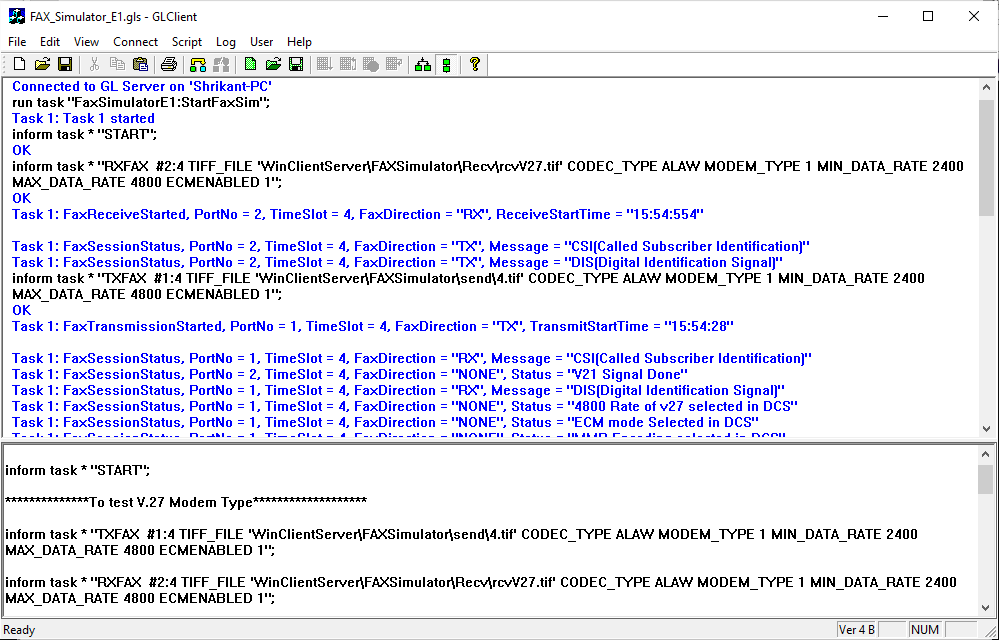
Typical Fax Session
Test Scenarios for Fax Emulator
Fax Emulator Between tProbe™ and FAX Machine (Over T1 E1)

Sample Script :
run task "FaxSimulatorE1:StartFaxSim";
inform task 1 "START";
inform task 1 "TXFAX #1:1 TIFF_FILE 'WinClientServer\FAX Simulator\send\3.tif' CODEC_TYPE ALAW MIN_RATE_TYPE 2400 MAX_RATE_TYPE 4800 PAGESIZE_TYPE 1 RESOLUTION_TYPE 16 ECMENABLED 1";
Fax Emulation over T1 E1 to Analog Interface on Dual UTA HD (via Channel Bank)
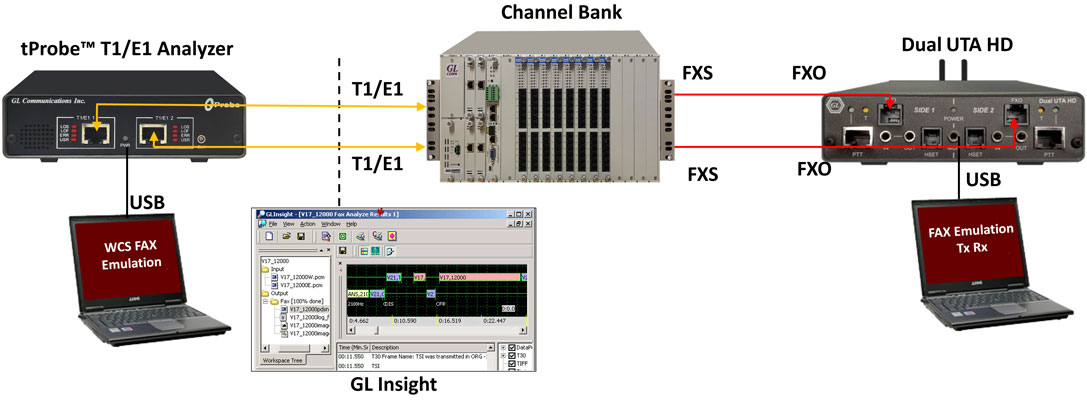
Sample Script:
inform task * "TXFAX #1:1 TIFF_FILE 'WinClientServer\FAXSimulator\send\1.tif' CODEC_TYPE ALAW MIN_DATA_RATE 7200 MAX_DATA_RATE 9600 ECMENABLED 1";

Analysis of PCM Files in GL Insight for V.29 Modem
Fax Emulation over tProbe™ FXO

Sample Scripts
Sending Fax from tProbe™ FXO Port to Fax Machine
run task "FaxSimulatorE1:StartFaxSim";
inform task * "START";
inform task * "TXFAX #2:1 TIFF_FILE 'WinClientServer\FAX Simulator\send\4.tif' CODEC_TYPE ALAW MIN_RATE_TYPE 2400 MAX_RATE_TYPE 4800 ECMENABLED 1";
This command will transmit 4.tif file on the port 2 timeslot 1 with the minimum and maximum data rate set to 2400 and 4800
Sending Fax from Fax Machine to tProbe™ FXO
run task "FaxSimulatorE1:StartFaxSim";
inform task * "START";
inform task * "RXFAX #2:1 TIFF_FILE 'WinClientServer\FAX Simulator\Recv\RCV.tif' CODEC_TYPE ALAW MIN_RATE_TYPE 2400 MAX_RATE_TYPE 4800 ECMENABLED 1";
This command will Receive the fax signal on port 2 timeslot 1 and save the image as RCV.tif.
Resources
Note: PCs which include GL hardware/software require Intel or AMD processors for compliance.
Please Note: The XX in the Item No. refers to the hardware platform, listed at the bottom of the Buyer's Guide, which the software will be running on. Therefore, XX can either be ETA or EEA (Octal/Quad Boards), PTA or PEA (tProbe Units),UTA or UEA (USB Units), HUT or HUE (Universal Cards), and HDT or HDE (HD cards) depending upon the hardware.
| Item No. | Products |
| XXFT0 XXFT2 XXFT3 XXFT4 XXFT5 XXFT6 |
WCS Fax Emulation Software (Requires one of the licenses below) |
| Related Software | |
|---|---|
| XX651 | MAPS™ CAS Emulator |
| XX649 | MAPS™ SS7 Emulator |
| XX648 | MAPS™ ISDN Emulator |
| VQT022 | VQuad™ Fax Emulation (2 simultaneous ports) |
| VQT022a | VQuad™ Fax Emulation (8 simultaneous ports) |
| FXT001 | GL Insight - Single Fax Analysis - TDM |
| FXT002 | GL Insight - Single Fax Analysis - IP |
| VBA038 | FaxScan™ for PCM |
| PKV104 | FaxScan™ for SIP and Fax over IP (T.38) |
| VQT251 | Dual UTA HD Next generation Dual UTA with FXO Wideband support |
| VQT252 | Dual UTA HD – Bluetooth Option |
| VQT461 | Dual UTA HD Smartphone ACC Cable |
| Related Hardware | |
| XTE001 | Dual Express (PCIe) T1 E1 Boards |
| FTE001 ETE001 |
QuadXpress T1E1 Main Board (Quad Port - requires additional licenses) OctalXpress T1E1 Main Board plus Daughter Board (Octal Port - requires additional licenses) |
| PTE001 | tProbe™ Dual T1 E1 Laptop Analyzer with Basic Analyzer Software |
| PTE015 | tProbe™ w/ 2Wire FXO and FXS Optional Board |
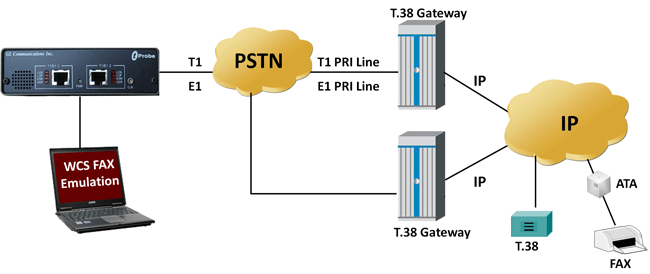
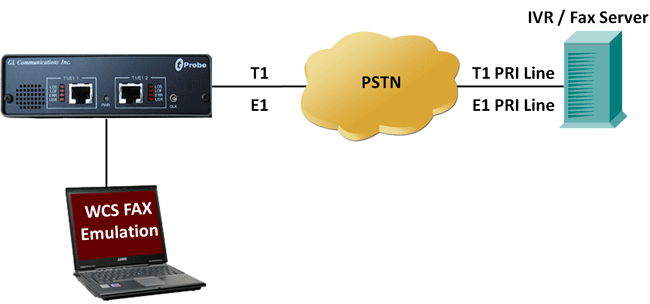
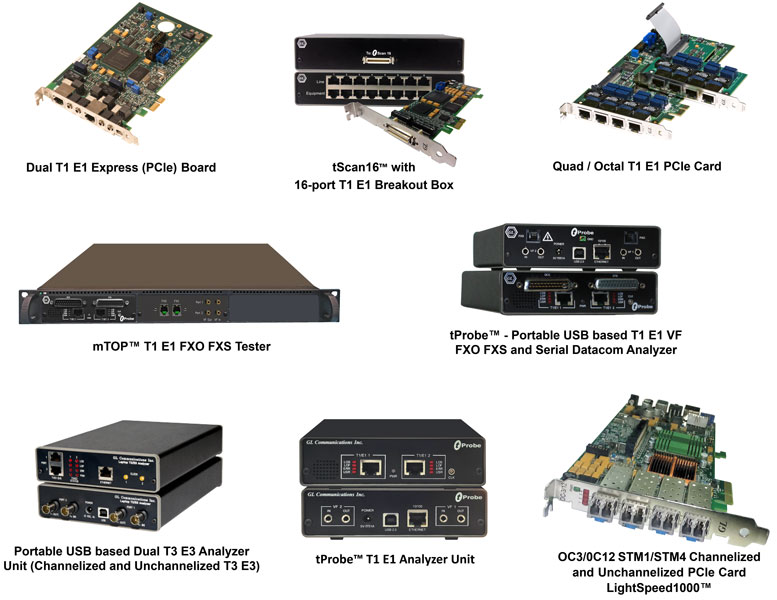
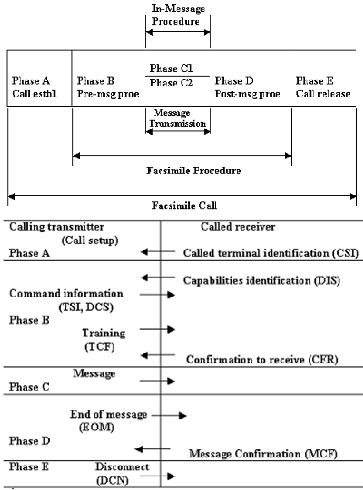
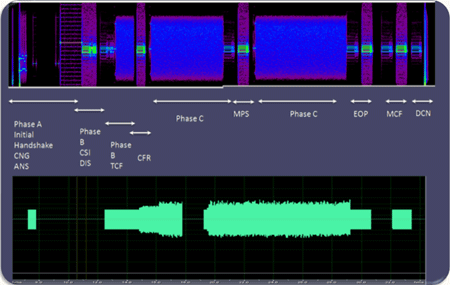
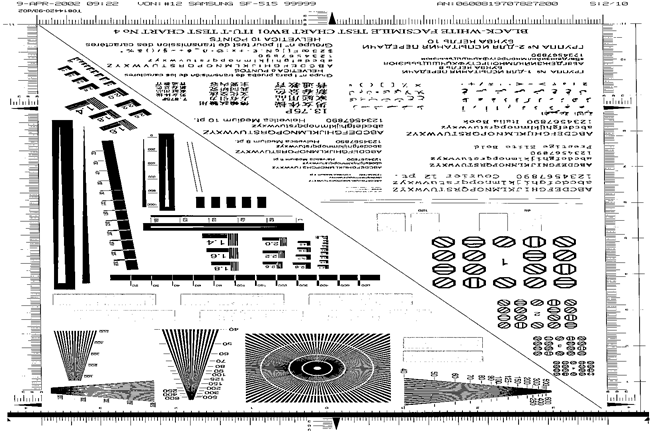
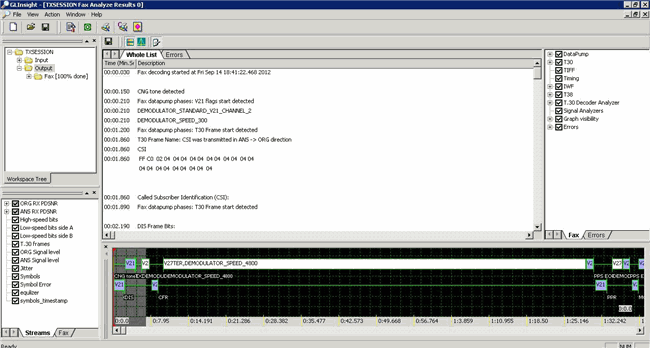
 Back to Client/Server Scripted Control Software Page
Back to Client/Server Scripted Control Software Page